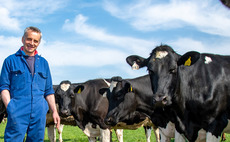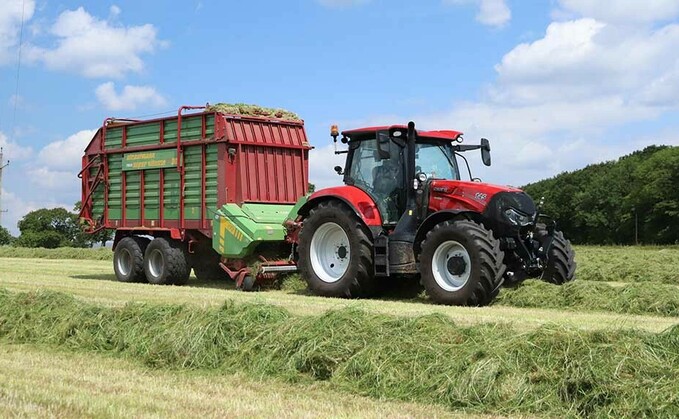
Now sporting a new semi-powershift transmission option and a revised engine layout and family look, Alex Heath puts Case IH's latest generation Maxxum tractor to the test.
With a legacy spanning 30 years, the Maxxum in its current format has been a part of Case IH's stable for nearly 10 years now.
But as of late the manufacturer seems to have developed a penchant for adding an increasing number of families in the power range which the Maxxum had a traditional pedigree in. So where does the latest range launched in 2016 now sit?
To find out, we took delivery of a Maxxum 145, complete with the newly developed ActiveDrive 8 transmission, exclusively available with the firm's Multicontroller trim.
The preserve of the Maxxum has historically been the company's answer to the high-spec, four cylinder, compact frame market.
However, the recent addition of the Luxxum and the Vestrum seems to have curtailed the Maxxum's reign of the pocket rocket mantel.
Wheelbase
One of the biggest and most noticeable differences between the old range and the new five-model lineup is the increase in its wheelbase of its four-cylinder models. No longer does the Maxxum have a stubby nose and sturdy stance, having recently grown by 250mm - talk about a growth spurt.
This has been achieved by adding a spacer between the engine and the transmission. As a result, the single six-cylinder model in the range now shares the same 2,650mm wheelbase as the four-cylinder models. It also means the bonnet and several other front-end components can be standardised.
This increase in length, while welcome when towing for greater stability, is potentially a hindrance when operating in tight yards.
When compared to the previous generation, the difference is quite discernible. The company quotes a turning radius of 11.88 metres when fitted with 480mm tyres, which is more than 1.5m larger than its predecessor.
However, the range now has a number of new features, including ‘quick steer', which goes some way to negating the turning circle growth by allowing quicker turns to be made with fewer spins of the wheel.
With a cut of silage to go at, we put the Maxxum to work with mowing, raking and harvesting duties, as well as a bit of tanking and mole ploughing to test its credentials as an all-rounder.
TRANSMISSION
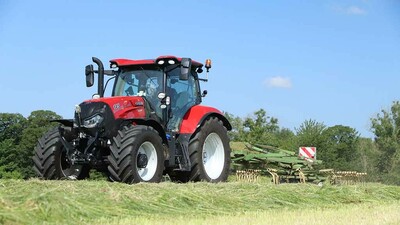
SPLIT over three ranges, the new ActiveDrive 8, as the name suggests, includes eight gears in each range, combining for a 24F/24R semi-powershift. While this may not seem radical, the way it works is, with a bucketload of configurable functionality.
Hardware of the transmission sees the engine output shaft diverted via one of two clutch packs and shafts. One shaft features all the odd gears, the other all the even.
It is the use of twin clutches which allows ratio changes to be lightning quick. The transmission is clever in the way it pre-empts changes too, pre-guessing the operator's next gear change and lining it up ready for the operator to engage.
Adding to the operational comfort of the transmission is the company's Smooth Shift function which matches gears to the current speed, allowing for good progress in-field or on the road without having to cycle through the whole range.
This avoids sudden surges in power as it prevents a lower than expected gear to be accidentally selected, and vice-versa.
Likewise, the automatic functions of the transmission give almost CVT-like simplicity. While not quite as smooth as a seamless box, gear changes at speed are almost imperceptible, with range changes only just noticeable.
Two different auto-modes can also be chosen; one for draft work and one for trailer type tasks. The first uses just the A range, while the second will cycle up and down the B and C ranges. The additional ability to easily select a start-up gear makes for a serene pull away, too.
Throttle
The eagerness of the transmission to change up can be controlled by the lever which you would have thought was the hand throttle. But this is actually used to control the rate at which it changes gear, based on the engine's rpm.
Pulled right back, it is quick to rattle through the gears, conserving fuel. Push the lever right the way forwards and it holds onto the gears, generating more power, ideal when towing a loaded trailer.
An automatic, driving the tractor can be done in much the same way as a CVT, pushing the Multicontroller joystick forwards to increase revs and thus forward speed. Pulling it back decreases the revs and the transmission will start to slide down the gears.
FUNCTIONALITY
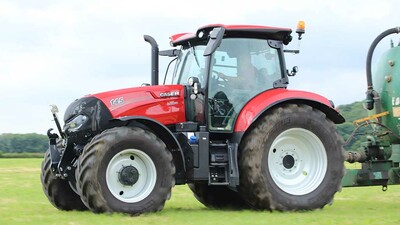
ANOTHER nifty feature the tractor now possesses is the company's Active Clutch 2 system which allows the clutch to be activated when the brake pedal is depressed.
Three levels of clutch engagement can be selected through the screen, altering how hard the brake pedal needs to be pressed before drive is disengaged.
As brake to clutch systems go, this one is near faultless and, for all intents and purposes, makes the normal clutch pedal redundant.
Only when needing to accurately find the bite point of the clutch while starting from the bottom of a steep bank without rolling back did the clutch pedal get touched.
Oh, and the obligatory jab at it to start the tractor up.
Further control over the transmission is also available, selected through the terminal.
In fully automatic the tractor will reach the highest speed the gear has to offer without governing engine rpm.
Alternatively, a limit can be selected if a precise speed is required. This is input using the rotary dial on the bottom of the joystick, with the tractor reaching the set speed before limiting its revs.
Conditions
When in this mode the tractor can be slightly slow responding to changing field conditions, either cycling up the gears as the wheels spin, or being slightly lazy when dropping down, so much so the engine nearly stalled on occasion.
Shuttle aggressiveness can also be set in one of three modes, with road, draft or loader applications catered for. The loader setting is the most aggressive, bringing the tractor to a swift halt before changing direction.
Each of the other settings adds about one second to the time taken to alter course.
CAB AND CONTROLS

WHILE the cab on the Maxxum is still a relatively comfortable environment, with space and visibility well catered for, it could do with some modernising.
The Multicontroller armrest and joystick are well laid out and functional, however, the blister pack styling does feel outdated and dare we say ‘cheap' compared to the other premium tractor brands' offerings.
Though the armrest on our tractor had an electric sliding function, ensuring the distance from the operator is easily changeable. A nice touch.
Various points of the cab have been updated in line with the tractor mother regulations, but this is pretty much limited to ensuring there are no sharp edges.
CAB
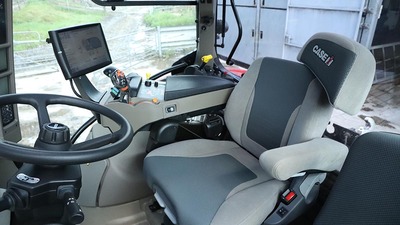
Clear
The AFS 700 screen is well proportioned and clear. However, layout and ease of use is still found wanting. We are told by the company that the screen is due for a major overhaul in the near future, with a more logical and easier way of changing machine parameters and programmes, such as its Headland Management Control 2.
However, the supreme surprise of the cab is the company's very comfortable dual motion seat, which features a swivelling headrest.
We did not know we needed this swivelling headrest until we used it, but, with the seat swivelled 15-degrees for better rearward views, the headrest can move sideways, providing more support across the operator's shoulder blades.
It can also be moved out of the way when using the pickup hitch, for example.
ENGINE
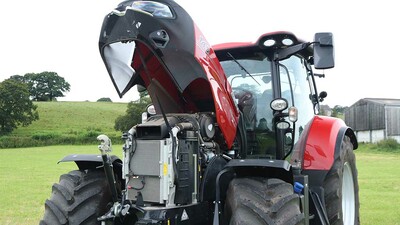
UNDERNEATH the aggressively styled bonnet, which has taken its design cues from the larger Optum series, is the 4.5-litre, four-cylinder engine from FPT, developing 145hp at 2,200rpm and a maximum of 175hp with power management.
Torque tops out at 700Nm at 1,500rpm, 40Nm lower than the six-cylinder, 6.7-litre engine found in the Maxxum 150.
Boost function kicks in when one of three prerequisites are met. These include pto load and road speed and hydraulic load is also added to the roster but, like the pto boost, it will only increase the power when the tractor is travelling faster than 0.5kph.
The company says the road speed boost will activate at speeds greater than 20kph, however, as anyone who has driven a recent Case will know, the boost is generous and engages almost instantly when the throttle is jabbed.
A mixture of work established the engine as a solid performer, eager to dispense power and taking a fair bit to drag it down, exposing the impressive torque which allows the tractor to keep trudging onwards.
text
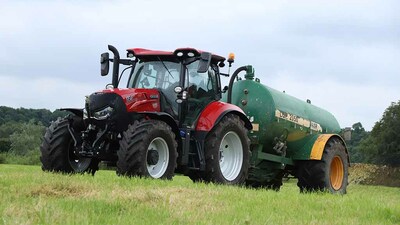
As an off-the-cuff comparison, the host farm's Puma 165 typically carries out the slurry spreading work, towing a 9,300-litre tanker and achieving about 20kph up a steep road out the farmyard. We were surprised to see the Maxxum easily match this, without breaking into a sweat.
Engine and transmission work well together and provide plenty of options for putting power to the ground in an efficient manner, without too many quirks.
Oil levels
Access to the engine bay is good, with the bonnet folding right up and out of the way. Filters fall easily to hand, while engine oil levels can be checked without opening the bonnet, on the right-hand side.
Daytime running lights are provided by strips of LEDs forming a brow above the main headlights, and a further 16 LED lights illuminate the field past dusk.
HYDRAULICS
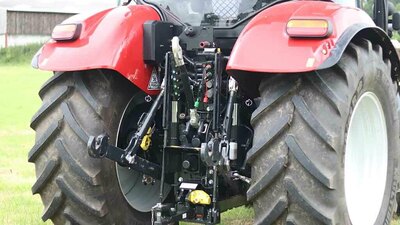
SPECCED with a 150 litres per minute variable displacement pump, most hydraulic applications are well covered. At the rear of the tractor, four spools are neatly arranged, while up to two can be positioned at the front.
Control over the spools can be done in a multitude of ways, including using the standard hydraulic paddles. In addition, linkage control and one spool can be assigned to the Multicontroller through the screen.
A third way is through the auxiliary joystick, which can also be used to control the front links and a loader if fitted.
Selecting which end of the tractor this joystick is used on is via a button on the armrest, with a host of options for where the oil is diverted.
However, it is a crying shame the joystick cannot be used to control a front spool and rear one, which would be handy when mowing with front and rear mowers, for example.
In all, the first spool can be controlled in as many as four different ways, with further controls for extending and retracting it found on the armrest's blister pack.
Control
Linkage control is simple and clearly laid out, with a rotary dial controlling the lower height and a selection of dials under the armrest's pad for maximum lift height and speed, among other functions.
At the rear, the spare hitch has been moved, now residing by the left link arm, rather than by the steps.
Two bars for storing link balls are also a convenient feature. As you would expect, linkage and pto controls can be found on both mudguards.
The hitch has also been revised, featuring a Sauermann locking bolt, rather than the hooks of old.
Verdict
THE new transmission is a welcome addition to the range, offering CVT like functionality with the dependability of a powershift.
Auto-modes and Active Clutch 2 really allow the operator to control the tractor with one foot and the new seat ensures long days piloting will not be too strenuous.
Interfaces
What Case IH can improve on is updating the cab and some of the control interfaces, but we have already seen this is in the pipeline with the launch of the new Magnum AFS.
And whether or not customers will welcome the additional bulk added to the four-cylinder tractors, bearing in mind it is now marginally shorter in its wheelbase than the firm's Puma models, time will tell.

















